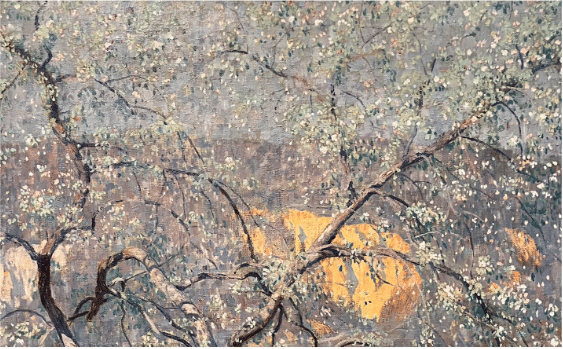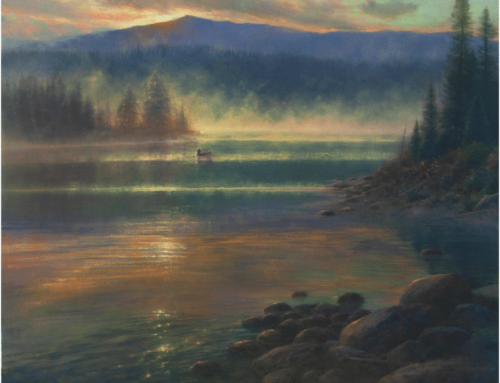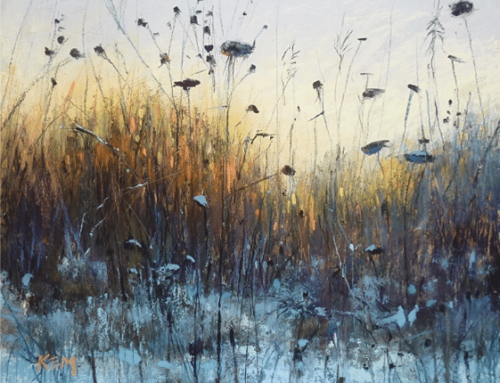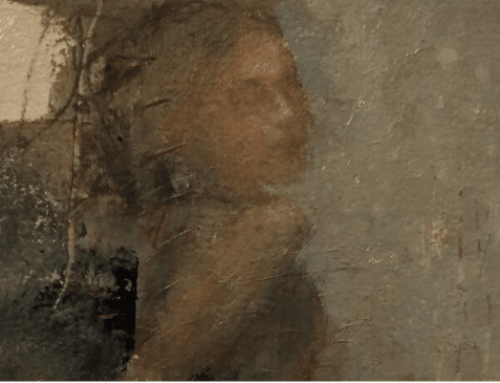William Lathrop and Daniel Garber, two classic Pennsylvania Impressionists, captured the spirit of spring in two different paintings in 1916. There’s something equally inspiring in each of them, but the differences between them can teach as much or more.
Both of these paintings live in the Philadelphia Academy of Art, where they are currently on display.
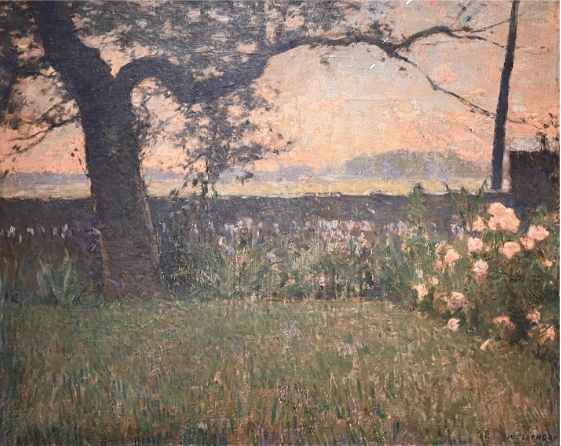
William Lathrop, Spring Landscape, oil (around 1916)
William Lathrop (1859-1938) is thought to be among the first Pennsylvania Impressionists. In 1898 he settled near New Hope, PA, where he founded an art colony that continues to thrive today.
Lathrop’s “Spring Landscape” (above) takes a straightforward approach to representing the landscape as it would appear to an observer, resulting in conventional, though no less carefully composed vignette of horizontal and vertical elements. He works a series of warm hues throughout the entire painting, giving the entire work a softly illuminated glow.
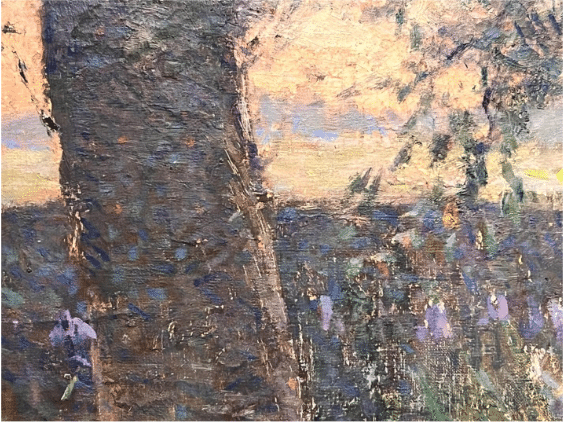
DETAIL: William Lathrop, Spring Landscape, oil (around 1916)
Closeups show how Lathrop used the classic Impressionist technique of “broken color” to render forms such as the tree trunk (above). Lathrop did not realistically rendeer the bark, or usew a flat color or series of naturalistic tones and “bark shapes.” Instead, Lathrop uses broken color to make the trunk read with the proper value but in a way that’s colorful and, the Impressionists believed, truer to the way light bounces off objects and hits our eyes.
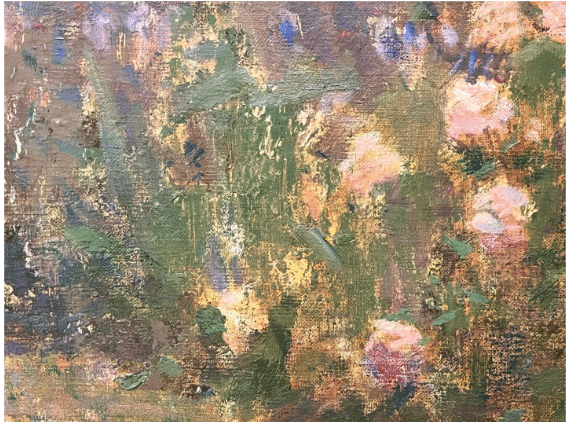
DETAIL, William Lathrop, Spring Landscape, oil (around 1916)
Older than his colleagues, Lathrop painted in an intimate, dreamy style based on memory, unlike the more monumental and outdoor compositions of some of his colleagues.
Turning to a spring painting by Lathrop’s friend Daniel Garber, we find many stylistic similarities, particularly a similar use of broken color, but we also encounter a completely different conception and approach.
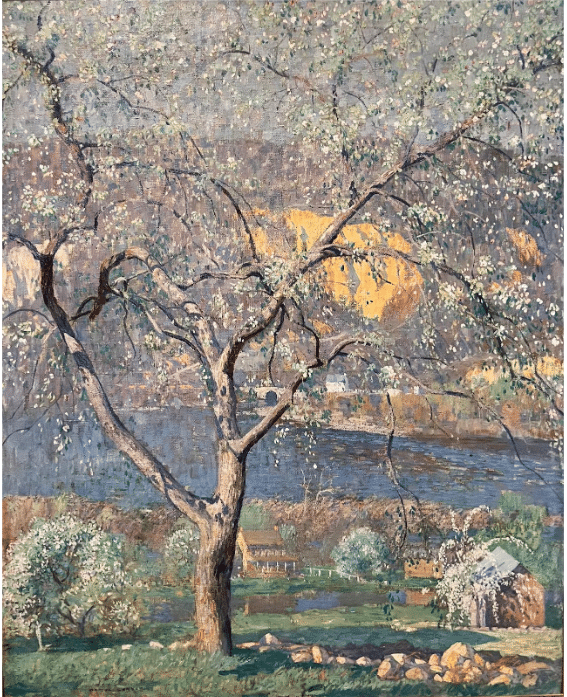
Daniel Garber, Buds and Blossoms, oil (1916)
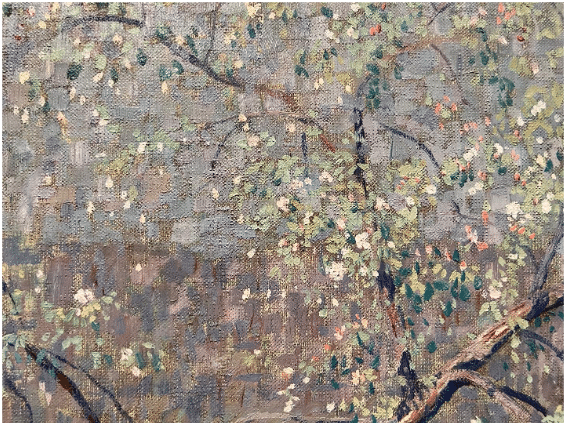
DETAIL Daniel Garber, Buds and Blossoms, oil (1916)
Like his fellow Pennsylvania Impressionists, Daniel Garber liked to paint outdoors. However, he didn’t share the perseverance of some of the artists in his circle, preferring to work in fine weather. Unlike Lathrop, who regularly worked from memory and imagination, Garber often waited for the light to be considered “most beautiful” before he would begin.
Garber described this depiction of the view from Point Pleasant, looking across the Delaware River to the quarries in New Jersey, as “his finest painting of spring.”
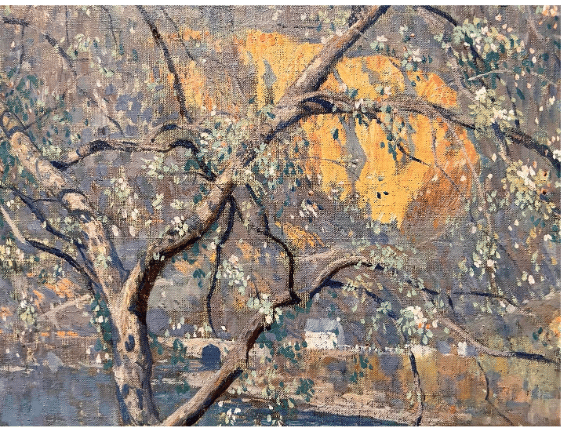
DETAIL Daniel Garber, Buds and Blossoms, oil (1916)
Where the artist’s colleague William Lathrop created his view with big simple shapes, Garber brings in a complex series of elements. Like Lathrop, Garber stacked his horizontal bands of landscape, water, and sky, but he linked them together by the network of branches on a flowering tree. Lathrop’s focus is the light as it falls over a landscape containing trees, and Garber’s focus is the tree itself and its magnificent fountain of blossoms. Garber’s approach may owe a debt to Japanese woodcuts that often traditionally foregrounded trees, whether cherry or plum, profuse with blossoms.
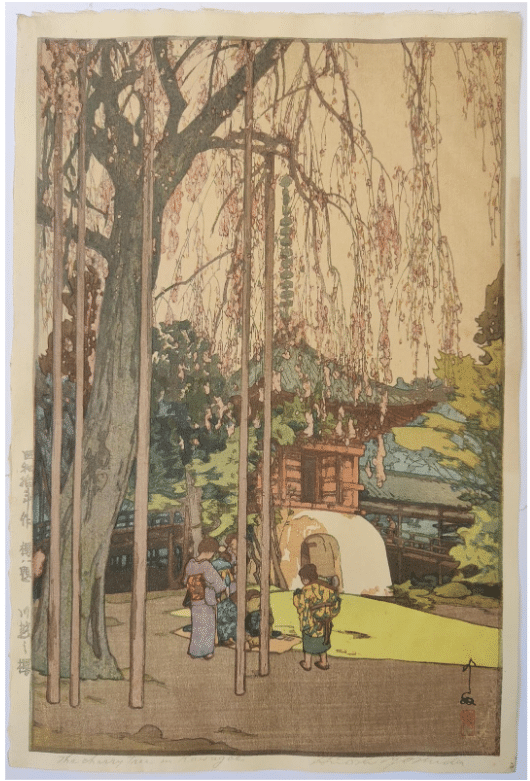
Yoshida Hiroshi, The Cherry Tree in Kawagoe, woodblock print
Impressionism is alive and well today among landscape painters, particularly those working plein air. Have a browse through a number of videos by contemporary landscape painters here.
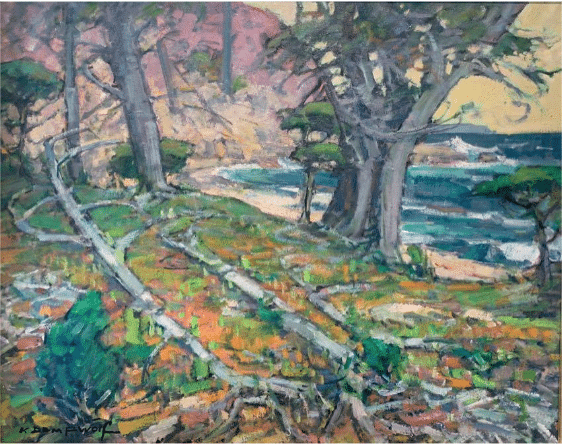
Karl Dempwolf, 17 Mile Drive, oil, 24 x 30 in.
Karl Dempwolf is a California Impressionist working today. He’s painting in – and extending – the American Impressionist style and approach.
He is a popular teacher and demonstrator, and you can check out his teaching video here.
Karl explains everything, from designing your scene, creating a pencil sketch to create the perfect composition, how to do a quick plein air study to capture the feel, and how to create a beautiful studio painting.
One of the most incredible things about Karl is that over the years he has developed a unique style that sets him apart from every other landscape artist. Having a signature style while still producing high-quality artwork is a dream for nearly every artist, and one of the best ways you can achieve that dream is to learn from this modern master. You don’t have to copy Karl’s style — he will tell you how to discover your own unique style.
As you watch and paint right along with Karl, one of the first things you’ll notice is how relaxed and confident he is — a natural state for this highly accomplished professional artist who has enjoyed a long and successful career. Spend time with Karl by way of this video, and you’ll just want to soak up everything he generously offers. You’ll see what he does that makes his paintings highly recognizable, and how you can take what you’re learning and apply it to your own artwork.
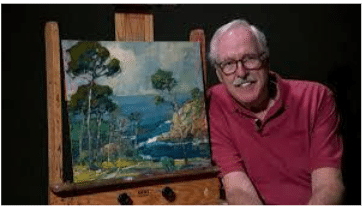
You’ll see every step Karl takes for each of his paintings:
- Pencil sketch: choosing what you like from the scene and developing your sketch
- Designing your composition to make a show-stopping painting
- Creating an on-location color sketch to grab the essence of color and light
- The way to properly transfer your drawing to your canvas
- The unique colors and materials you’ll need
- Karl’s exclusive approach to creating harmony in a painting with color
- The important first steps for correctly blocking in the design
- Using color to bring the masses of shape alive, and making critical adjustments
- Knowing when and why to quit — a lesson most artists need to fully understand
- The proper way to match a frame to make your painting stand out

